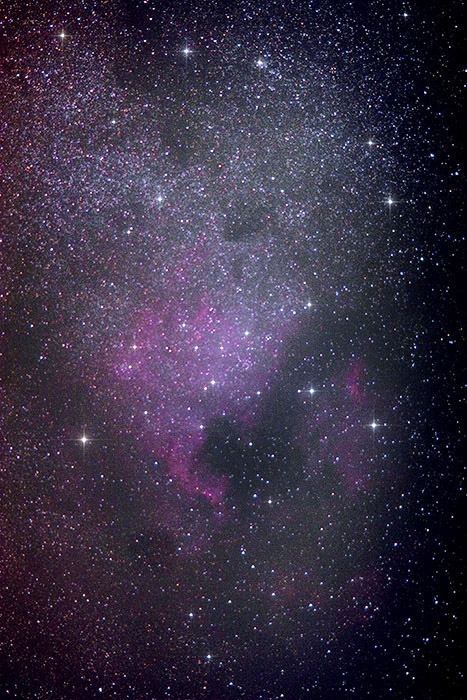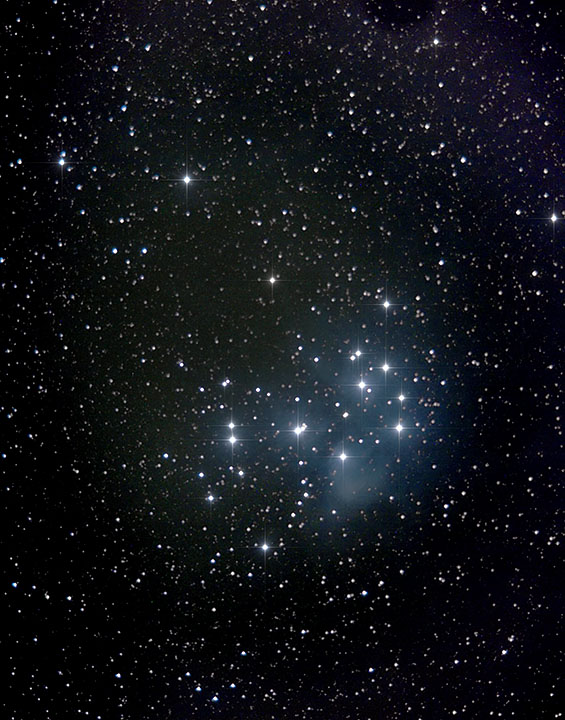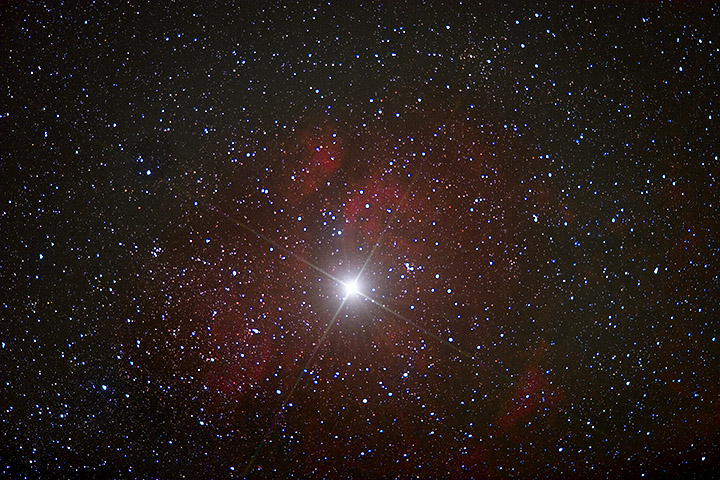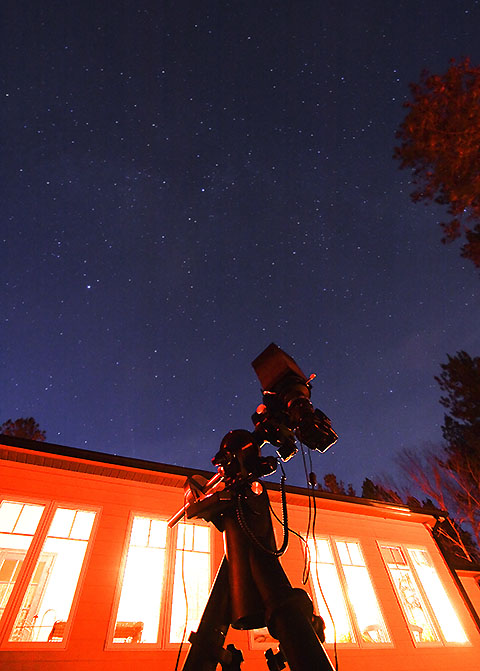|
|
11/14/2009. Last night, I did some sky trials with the 200mm F2.0. Largely frustrating, but, still and all, not bad results for what are comparative snapshots. Fifty seconds? What kind of exposure is that for a deepsky object? In the early hours of deep twilight, the western sky was mostly cloudy or at least hazy, but I tried one quick frame of NGC 7000. Some unidentified tracking issues and clouds blowing through meant I got only one marginal frame. Even allowing for these problems, none of the images is all I would like. None is as clean as I had hoped and expected. Most of the defect may be due to focus (micrometer, live view, and magnifiers be damned; it's still hard to find the best focus with this lens) or maybe there is cause for more subtle adjustment, or maybe cause for a change in workflow. Based on the one decent frame, here's the North America Nebula; 50 seconds at F2.0, ISO 800, Hap Griffin modded Canon 20D, dodging clouds:
Next, I ran 90, 1-minute exposures of the Pleiades. Focus was off. How in the — ? It was far enough off that Maxim won't auto-align on stars (apparently 'cause it doesn't see any). But not so far off that something couldn't be salvaged. Here are the first five frames, manually aligned in Maxim and carefully stretched in Photoshop:
<Sheepish grin> I hadn't appreciated the degree to which those sharp spikes would improve the perceived sharpness of otherwise, err, "marginal" images. That, and shrinking them for web display. The original images of the Pleiades have a FWHM point spread of 6.2 pixels (two or three would be better). Even at that level of fuzz, we're getting on toward Mv 13.5 or so in 1 minute which suggests that perfect focus might get us well into the 15's (I recall a pro survey using similar lenses feeding efficient CCDs which was reaching 18 with short exposures, so don't be too impressed). With color images of DSLR size, Maxim can take its sweet time, especially when manual alignment is involved. I didn't think it worthwhile to spend all day (or more) combining a large pile of poor data. Better stuff tonight, weather willing. In the first batch, there's some potential for a nice animation as the Pleiades passed through the upper boughs of a pine tree, but that, too, is for another day. Some notes:
OK, now get to work for tonight. Make sure the micrometer is working right, and find out how to cut Kydex neatly. And shoot some flats. And move the mount to keep the Pleiades out of the tree.
November 14. People, it's been that kind of day. The Kydex I ordered to make a light- and dewshield for the 200mm arrived, but it was much thicker and less flexible than expected. So instead of a nice, round conventional dewshield, I made a rectangular, boxy one. And while cutting one sheet, I got confused and made the second cut the wrong way, so instead of it being 12-inches deep, it's more like 9.5. That's plenty, as it turns out, but it's just the way things have gone. I used some epoxy putty to hold things together and then wrapped plenty of heavy-duty black duct tape around it. Then I applied ProtoStar's flocking paper to the inside. All in all, it's a very sturdy, dark, shield. And ugly enough to work, too. You know how honest to goodness observatory stuff looks -- all business and no shelf appeal? -- it's like that. In six hours on a very humid and cool evening, not a bit of dew formed on the lens although it is soaking everything else. Score one for me, in spite of myself. I also rebuilt the micrometer focusser for the 200mm. The bracketry gave it some slack last night and it has none now. I put it on the other side of the lens, too, so that when I use it with a guide-scope I don't have to reach between them to focus. The next project of the day: a focusing mask similar to the one I use with the 5-inch as recommended by Ron Wodaski in his CCD book. It doesn't work nearly so well, though -- too short a focal length? Misaligned? Anyway, something else to troubleshoot. I verified that adding the IDAS LPR clip-in filter DOES produce a significant focus shift with this lens (what doesn't?). So I decided to shoot test frames with it in the 50D rather than in the 20D -- live view being critical to get focus close. This will be even more important in H-a, but the 50D is blind to it. So I spent some time tonight getting ready to outfit the Aspire One netbook as a focusing aid by using it to examine the 20D's exposures. Do not start shooting with the 200mm at F2 at ISO 1600 until you're sure it's dark. It looked pretty dark to me when I shot a series of 100-second images of Sadr. Here's the best frame as it came out of the camera and as it looks after a little work:
Not bad for such a brief exposure in twilight, eh? See previous remarks for the relationship between perceived sharpness and digital diffraction effects. Here's a slightly confusing perspective on the 200mm (with ugly but very effective hood) on the G11 under a not-quite-dark-enough sky (10-22mm Canon EFs @ 10mm, 30s, F4.5, ISO 1250, Canon 50D):
|
:: top ::
© 2010, David Cortner




